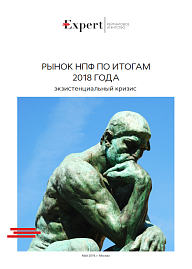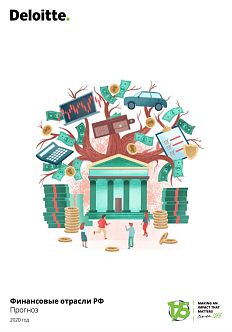In 2018, the gap between the actual condition of the non-state pension (NSP) market and what it was intended to be reached an apogee. The market was designed as a government-independent institution responsible for accumulating, holding and augmenting the pension assets (savings) of retiree citizens. In practice, the contribution (funded) component of the Russian pension system is «frozen», some pension funds perform poorly, many citizens continue to lose their money after switching from one pension fund to another, and the market is concentrated with a handful of large state-owned entities. Because no significant inflow of new pension money is expected in 2019, strong rates of return are paramount for a pension fund to stay afloat.
.png)
In 2018, the Russian non-state pension market increased 6.4% YoY to RUB 3,850 billion. The pension savings growth rate decreased more than twice compared with that in 2017 (12.2%), making the increase in absolute terms the lowest since 2011. The continued shedding of toxic assets from some NSPF portfolios has had an even greater adverse effect on market return in 2018 than a year earlier. As a result, the weighted average rate of return on pension investments was hardly above zero (0.1%). The average OPS account balance has been declining for the second year in a row. In 2018, it decreased to RUB 68,000 from RUB 69,200. The overall positive dynamics was driven by the PFR-to-NSPF cash flow (+RUB 163 billion) and the rate of return on invested pension reserves (5.2%) which was considerably higher than that on pension savings. Some NSPFs have faced the negative revaluation of their assets, but its adverse impact on the aggregate value of the pension reserve portfolio has been less significant.
.png)
The market is consolidating in anticipation of the switch to the Individual Pension Coefficient (IPC); the leading pension funds are merging or acquiring smaller players. In 2018, there were several pension fund groups, which completed the integration of their businesses. This produced changes in the list of the NSP market leaders and fostered the consolidation process. By year-end 2018, top-10 NSPFs accounted for almost 90% of total pension assets, making the NSP market an oligopoly. The market saw several consolidation centers, mostly represented by funds with links to industrial or financial government-related entities. Although the future of the NSP market is highly uncertain, it is clear that only financially strong NSPFs with advanced IT systems and other resources, affordable to larger market players, will have access to new flows of pension money. In such circumstances, many smaller NSPFs will either look for strategic investors or leave the market.
The problems of isolation and lack of growth drivers in 2019 make the pension market dependent upon the NSPFs profitability ratios. Since the pension savings were «frozen», there have been no alternative long-term growth drivers in the market. The money of «molchuny» («the silent ones», whose OPS accounts are still with PFR) became a market driver for a short time. However, the very poor results of the latest transition campaign to transfer OPS accounts to NSPFs (+RUB 40.4 billion) suggest that this opportunity has been exhausted and the pension market will face stagnation in 2019. At the same time, the decreasing PFR-to-NSPF cash flow can be offset by the NSPFs higher profitability and return metrics. A number of NSPFs have largely disposed of their impaired assets, and new credit risks became less likely to occur as the quality of investment portfolios significantly improved. The weighted average rate of return on pension assets will range between 6% and 7%, absent external shocks. If there are large external shocks, it will decline to 6-7%. The Expert RA analysts expect the non-state pension market to speed up to 8% against the disastrous 2018, and the total pension assets to reach RUB 4.2 trillion.



